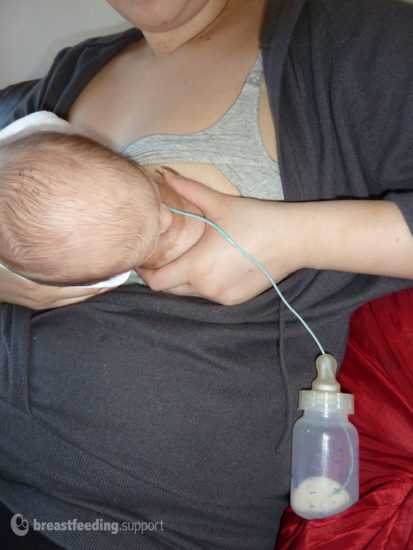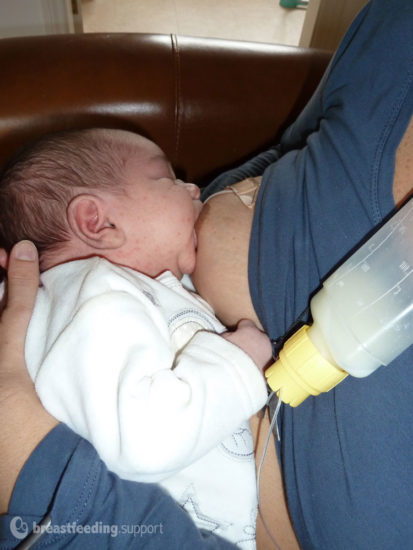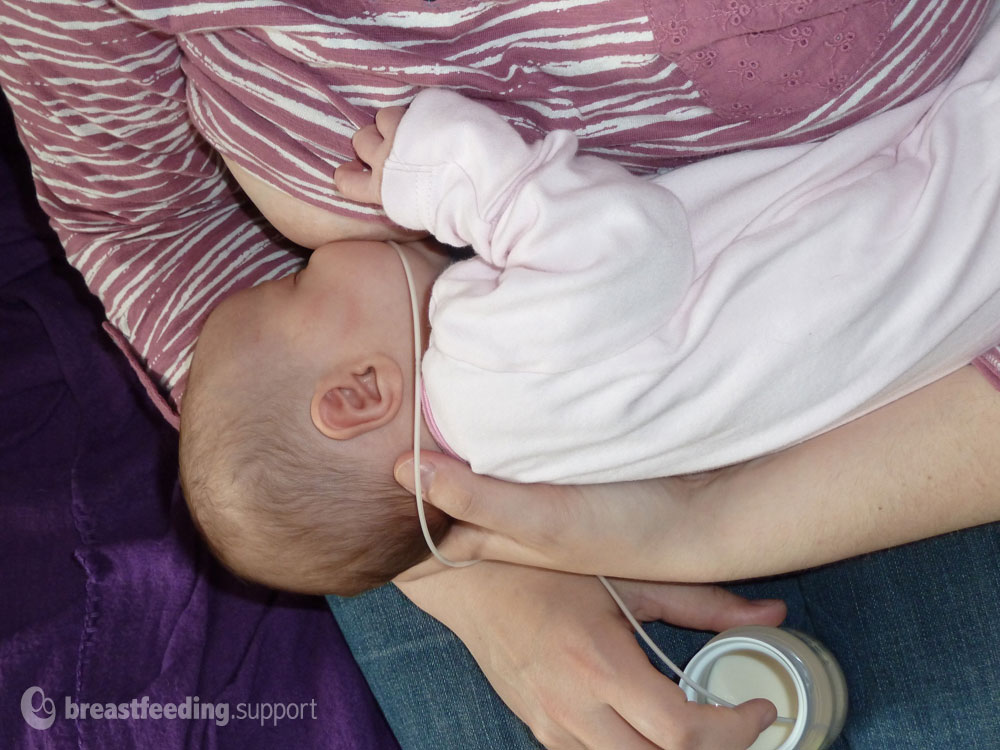An at-breast supplementer, nursing supplementer or “supply line” allows a mother to feed her baby supplemental milk at the breast. It can be used as a short-term aid on the way back to full breastfeeding and can sometimes be used longer-term. The feeding tube can also be used as a way to finger-feed your baby either as a sucking exercise or when transitioning your baby back to the breast. Keeping in touch with an International Board Certified Lactation Consultant (IBCLC) or your health professional is advisable while you are using an at-breast supplementer. For the pros and cons of this method of feeding and further information on commercial supplementers and how to use them see Supplementing at the Breast on this website. This article describes how to make a homemade supplemental nursing system.
Making a homemade supplemental nursing system
A homemade supplemental system can use a range of equipment to hold the supplement including an open cup, here we describe setting up using a baby’s feeding bottle or a syringe.
You will need
- An ordinary feeding bottle and teat or a syringe to hold the supplement
- A 5 or 6 French, 50cm or 90cm length feeding tube (nasogastric tube)1
- A 5ml or 10ml syringe for flushing and cleaning the tube—your local pharmacy may sell these or some online stores sell individually wrapped sterile syringes.
Setting up if you are using a bottle and teat
- Slightly enlarge the hole of a bottle teat or vent (with clean scissors) so that you can feed the tubing upwards through the teat. The plastic attachment (an open/close valve) on the feeding tube sits in the milk at the bottom of the bottle (make sure the valve is open). A tight fit for the tube through the bottle nipple will reduce spillage.
- Add your expressed breast milk or formula supplement to the bottle. Screw the artificial teat onto the bottle with the feeding tube threaded through it and the valve end of the tube submerged in the milk.
- Piercing a second hole in the teat, or using a teat with a vent, allows air into the bottle so your baby doesn’t need to suck harder as the bottle empties. Some mothers find it works well without the extra hole.
- Place the bottle on a table close to where you are feeding your baby, or put it in a shirt pocket, between your breasts or between your knees depending on the length of the tube.
- The free rounded end of the tube should lie alongside your nipple—or just behind the nipple—and be taken into your baby’s mouth with the nipple and a big mouthful of breast tissue when they begin to suckle. Alternatively you can latch (attach) your baby on the breast first, and then slide the tube into the corner of their mouth when you are ready—for example after your baby has breastfed on both breasts first. Ensure that the tube isn’t extended further than your nipple or it may make your baby gag or reach the back of his throat (using tape can help with this, see next point).
- Some mothers find it useful to tape the tube to their breast with surgical tape or a sticking plaster and others prefer not to—experiment to find what works for you. If you tape the tube to your breast before your baby latches, make sure the tape is far enough away from your nipple so that it won’t interfere with your baby’s latch.
- When baby has a good seal around the breast and tube, the supplement will be sucked up the tube into their mouthed you will see that the tube looks white when full of milk.
Setting up if you are using a syringe to hold the supplement
- Fill the syringe with expressed breast milk or formula supplement.
- Push the end of the syringe into the open valve of the feeding tube.
- The syringe could be tucked under your bra strap, clipped to the bra strap or held in a spare hand
- You will usually see the plunger slowly close of its own accord when baby suckles as the syringe will slowly empty. If you only have a small syringe you may need to refill it during the feed.
- See steps 5–7 above.
Adjusting milk flow with the bottle
If your baby can make a good seal on the breast with the tube in place, you will soon see milk rise up the tube into his mouth and he will start swallowing. If the flow of milk seems too fast (your baby is gulping milk too quickly) or too slow (you can’t hear many swallows) you can alter the flow by;
- Adjusting the height of the bottle of milk. The bottle containing the supplement should not need to be held higher than your baby’s head to work. The higher the bottle the faster the flow of milk.
- Using different sized feeding tubes. The wider the diameter of the tube the faster the flow of milk, 6 French (6 fr) is a wider tube than 5 fr.
- Pinching the tube to narrow the diameter and slow the flow.
A guideline to aim for is seeing baby suck once or twice for every swallow.2
No milk?
If your baby struggles to suck milk up the tube to get the flow started he may start to get frustrated. Briefly lifting the container of milk higher than baby’s head can help to get the flow started by capillary action if needed. If using a syringe the tube can be prefilled with breast milk by pressing the plunger on the syringe just enough to fill the tube. You may also need to:
- Adjust the latch. Supplementing at the breast relies on good positioning and attachment.
- Adjust the tube. You may need to adjust the position of the tube in your baby’s mouth slightly. It may be helpful to hold the tube in place if you’re not using tape as sometimes a baby will push the tube out of their mouth with their tongue.3 Jack Newman, a Canadian paediatrician and breastfeeding author, shares his tips for inserting the tube in the excerpt below:
Gently ease the breast away so the corner of the baby’s mouth is seen.
Hold the tube close to the end with your index finger and thumb. Bit by bit, slide the tube under the baby’s top lip (anywhere between the middle of the top lip and the corner of the mouth). The tube should slide into baby’s mouth alongside the nipple – push the tube away from the breast and aim it toward the roof of baby’s mouth.
Cautions—important
- Discuss with health care team. Supplementing with a homemade or commercial supplemental system or supply line at the breast is mentioned in lactation textbooks.45 endorsed by some hospitals67 and advocated by some medical professionals8 but parents are encouraged to discuss the suitability of this feeding method with their own health professionals and lactation consultant as it may not suit every baby.
- Use at own risk. A single use nasogastric feeding tube is manufactured to be used as a feeding tube that carries food internally via a baby’s nose and throat into their stomach—not as an external feeding mechanism to run alongside the breast or finger. Please note that when using any device in a different way to a manufacturer’s intended use you do so at your own risk. Commercial purpose made versions of supplemental nursing systems are available for long term use—see Supplementing at the Breast for further details.
- Feeding tubes are very difficult to clean properly and need to be replaced frequently, see next section.
Replace feeding tubes every day
Single use nasogastric feeding tubes are not made to withstand boiling or steam sterilisation which makes them very difficult to clean properly. Chemical cleaning by cold water sterilisation could also break down the tube lining. Disposable tubes should therefore be replaced frequently with new. In their fact sheet, the Royal Women’s Hospital in Australia advise replacing tubes (and the syringes used to flush them out) every 24 hours.9 Canadian paediatrician Jack Newman discusses that with careful washing, tubes may be reused for a few days. 10
- Inspect tubes carefully for signs of wear and tear before use and bear in mind that although tubes may look clean, bacterial cultures may be building inside.11
- If your baby is premature, or particularly vulnerable to infection it will be especially important to discuss using a homemade supplementer with the health professionals caring for your baby, to observe very careful hygiene and replace the tubes very frequently.
Cleaning the homemade supplemental nursing system
Cleaning the bottle and teat
Clean and sterilise the bottle and teat or syringe as usual—See Sterilising Baby Bottles (National Health Service website, 2023).
Cleaning the feeding tube
Rinsing and cleaning tubes as soon as possible after use will remove any milk residue before milk can start to dry in the supply line. Precise cleaning instructions for feeding tubes vary slightly between practitioners. Washing instructions include:
- Push cool boiled water through the feeding tube with a 10ml syringe in the end-cap straight after use at least three times as needed.12 Warm water for the initial rinse could cause the milk to curdle and stick to the inside of the tubing making cleaning more difficult.
- After thoroughly rinsing with cold water, some recommendations advocate flushing the tubes with hot soapy water and then rinsing thoroughly.1314
- After washing, shaking the tubes (e.g. making a lasso action with the tube) can remove most of the water inside. They can then be left to dry (Newman, 2016) or stored in a clean sealed container in the fridge.
- Change the tube and syringe for new ones every 24 hours.
See below for cleaning information from the Royal Women’s Hospital fact sheet, and Counseling the Nursing Mother:
- The feeding tube must be cleaned thoroughly as soon as the feed is finished. Rinse the tube using a syringe to remove any milk from the tubing and to avoid the growth of bacteria – this is particularly important when infant formula is used.
- The tube can be re-used for a total of 24 hours. Each 24 hours the tube must be discarded and replaced with a new tube.
- Use the 10ml syringe to flush 10mls of cooled boiled water through the tube.
- Flush the tube at least 3 times, more if there is any milk still visible in the tube.
- Always store the cleaned tube and syringe in a clean sealed container or plastic bag in the fridge.
- Boiled water can be made up for the whole day – boil fresh water in the kettle and pour into a clean container to cool. Cooled boiled water can be kept for 24 hours in the fridge and used as required for cleaning.
After every use the tubing needs to be flushed with cold water, washed with hot soapy water, and then rinsed with clear water.
For cleaning information for tubes supplied with a commercial supplementer—always check the manufacturer’s instructions.
Useful video
Setting up a homemade supplemental system by Charlotte Yonge, IBCLC
Summary
A homemade supplemental nursing system can be used as a way to give your baby supplemental milk at the breast or via finger feeding. It is an alternative to commercially available supplementers, cup feeding, or using a bottle. Supplementing at the breast is not suitable for all babies and is best used under the supervision of an IBCLC lactation consultant or other health professional. A homemade system involves adapting the use of a disposable nasogastric tube which is not intended to be repeatedly washed and reused, so tubes must be replaced often and parents use the system at their own risk. This article should be read in conjunction with Supplementing at the Breast which discusses all the advantages and disadvantages of using this kind of device.


